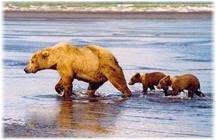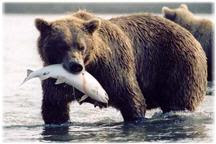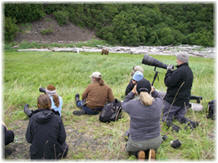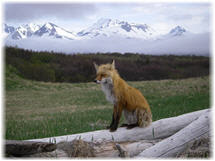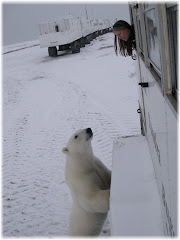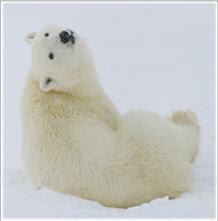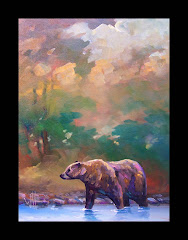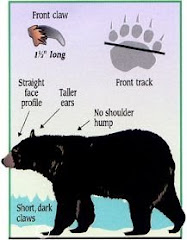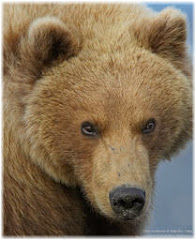In Alaska, the raven can only be confused with a hawk or the much smaller crow. Ravens have large, stout bills, shaggy throat feathers, and wedge-shaped tails, visible best when in flight. Common ravens are large passerine (or perching) birds that average 63 centimeters (25 inches) in length and 1.2 kilograms (2.6 pounds) in weight.
Monday, March 31, 2014
The Raven
The common raven (Corvus corax) is a member of a
family of birds known as the Corvidae, which includes jays,
crows, and magpies.
In Alaska, the raven can only be confused with a hawk or the much smaller crow. Ravens have large, stout bills, shaggy throat feathers, and wedge-shaped tails, visible best when in flight. Common ravens are large passerine (or perching) birds that average 63 centimeters (25 inches) in length and 1.2 kilograms (2.6 pounds) in weight.
In Alaska, the raven can only be confused with a hawk or the much smaller crow. Ravens have large, stout bills, shaggy throat feathers, and wedge-shaped tails, visible best when in flight. Common ravens are large passerine (or perching) birds that average 63 centimeters (25 inches) in length and 1.2 kilograms (2.6 pounds) in weight.
Sunday, March 30, 2014
Bear Hugs Project
A Warm Thank you to one of the local Quilting Groups for making many lovely, warm, beautiful quilts for the teddy bears and the kids in the Bear Hugs Project.
We started the Teddy Bear Hugs Program in the spring of 2012 after
taking a tour of some of the non-profit organizations around Homer.
We toured one called the Haven House which helps abused children,
women and men get through very difficult times in their lives.
One of the rooms that they have is called their 'safe room' in which the police and councilors talk with the abused children to find out what happened to them. During the interview with the children, they are allowed to choose a teddy bear to hold and hug. This is in an attempt to give the child a feeling of safety and caring in hopes that the child will feel comfortable enough to tell the police what happened to them so the offender will be caught and charged for their horrible crime. After the interview, the child is allowed to keep the teddy bear they were hugging and the child is then sent to a safe location to live with caring relatives or family friends that will care for and protect them.
We noticed that during our tour of the Haven House they were terribly short of teddy bears. In our community alone they say they go through 250 teddy bear per year. Now just imagine how many teddy bears other Haven House organizations go through in larger communities.
A teddy bear may be such a small thing to donate in the grand scheme of things when you really look at what horrible things these children go through at the hands of abusers but it is amazing what hugging a teddy bear can do to comfort someone, young or old.
Over this summer we found that not only adults wanted to donate teddy bears but kids wanted to help out as well. One does not have to buy a new teddy bear but only to talk with their kids and have them pick one from their room that they want to donate to a child in need. We had a lot of kids this year give one of their own teddy bears to the project, and that just warms the heart.
Anyone wishing to donate a teddy bear, feel free to find new or gently used teddy bears and bring them up to Alaska with you when you visit us or mail them.
We are also promoting people to donate teddy bears in their own community as well if they do not wish to mail one up to us in Alaska. We are hoping this idea will spread to other areas and communities around the world.
One of the rooms that they have is called their 'safe room' in which the police and councilors talk with the abused children to find out what happened to them. During the interview with the children, they are allowed to choose a teddy bear to hold and hug. This is in an attempt to give the child a feeling of safety and caring in hopes that the child will feel comfortable enough to tell the police what happened to them so the offender will be caught and charged for their horrible crime. After the interview, the child is allowed to keep the teddy bear they were hugging and the child is then sent to a safe location to live with caring relatives or family friends that will care for and protect them.
We noticed that during our tour of the Haven House they were terribly short of teddy bears. In our community alone they say they go through 250 teddy bear per year. Now just imagine how many teddy bears other Haven House organizations go through in larger communities.
A teddy bear may be such a small thing to donate in the grand scheme of things when you really look at what horrible things these children go through at the hands of abusers but it is amazing what hugging a teddy bear can do to comfort someone, young or old.
Over this summer we found that not only adults wanted to donate teddy bears but kids wanted to help out as well. One does not have to buy a new teddy bear but only to talk with their kids and have them pick one from their room that they want to donate to a child in need. We had a lot of kids this year give one of their own teddy bears to the project, and that just warms the heart.
Anyone wishing to donate a teddy bear, feel free to find new or gently used teddy bears and bring them up to Alaska with you when you visit us or mail them.
We are also promoting people to donate teddy bears in their own community as well if they do not wish to mail one up to us in Alaska. We are hoping this idea will spread to other areas and communities around the world.
Saturday, March 29, 2014
Bear Facts
- Sloth bears are the only bears that are more active at night.
- Polar bears have a thick coat with 9,677 hairs per square inch.
- Most bears are born without fur. Only polar bears and giant pandas are born with thin white fur.
- Bears have nonretractable claws like dogs and unlike cats.
- While most bears have bare feet, the paws of polar bears have fur on the bottoms and between the toes. Bears lose most of their heat from their paws.
- Like people, all bears except pandas walk by putting their feet flat on the ground. This kind of walking is called “plantigrade.” In contrast to bears, other large animals including dogs, horses, and even elephants walk on their toes.
- The claws on the front feet of bears are longer than the claws on the back feet. Some large bears have claws almost 5" long.
- Bears are the only large predators that regularly eat both meat and plants. For this reason, they have different teeth specifically used for meat eating and plant eating.
- During hibernation, a bear does not defecate. Its body can somehow recycle body waste into protein, a process scientists still do not understand.
- Not all bears hibernate. Asiatic black bears, American black bears, some brown bear species, and pregnant polar bears hibernate. Sloth bears live in warm places with abundant food, so they don’t need to hibernate.
Friday, March 28, 2014
Wednesday, March 26, 2014
The World of Polar Bears
Females are sexually mature when they are 3–6 years old.
Males reach sexual maturity at 4-5 years of age, but are
generally not successful breeders until after 6 years of
age. The breeding season for polar bears is March through
May. A male will find a female by following her scent and
tracks across the sea ice. After mating, the development
of the fertilized egg (blastocyst) is delayed and does not
implant in the female’s uterus until August. Once the
embryo begins to grow, the gestation period is only 4-5
months. In October and November, a pregnant female will
find a denning area either on land or on the sea ice. She
creates her den by making a depression in the snow on a
bank or slope or near rough ice. As snow drifts form, she
will increase the size of her den. The cubs (usually
twins) are born in December and weigh 1-2 lbs and must
remain in the protection of the den until they grow
bigger.
By late March or early April when the cubs weigh ~15 lbs, they leave the den. For the first few days, the family will make short trips and return to the den giving the cubs time to acclimate to the temperatures outside. After this time, the group will travel to the drifting sea ice. The cubs will remain with their mother for about 2 years and then the female will mate again.
By late March or early April when the cubs weigh ~15 lbs, they leave the den. For the first few days, the family will make short trips and return to the den giving the cubs time to acclimate to the temperatures outside. After this time, the group will travel to the drifting sea ice. The cubs will remain with their mother for about 2 years and then the female will mate again.
Tuesday, March 25, 2014
Red Fox
The red fox is common in most of northern North
America. It is found throughout Alaska, except for
some of the islands of Southeast Alaska and the
western Aleutians and is rare in Prince William Sound.
It is native to Kodiak Island but is an introduced
animal on many islands in the state as a result of fox
farming operations in the early 1900s. Red fox
populations in Southeast Alaska are sparse, but the
animal is found in the Taku and Stikine river valleys
and the Mendenhall Flats.
Red foxes have also been seen on Douglas Island near Juneau. The fox prefers broken country, extensive lowland marshes, and crisscrossed hills and draws. It is most abundant south of the arctic tundra. It is also present in tundra regions, which it shares with the Arctic fox. Where the ranges of the two species overlap, the red fox is dominant. In these areas, red foxes have been observed digging white (Arctic) foxes from their dens and killing them.
In areas where foxes have had little contact with humans, they display cautious curiosity. Even less fear is shown where contacts with humans are very common. Foxes are very adaptable to a wide range of habitats and can thrive close to humans, but they prefer wild settings. They require only a source of food and cover.
Red foxes have also been seen on Douglas Island near Juneau. The fox prefers broken country, extensive lowland marshes, and crisscrossed hills and draws. It is most abundant south of the arctic tundra. It is also present in tundra regions, which it shares with the Arctic fox. Where the ranges of the two species overlap, the red fox is dominant. In these areas, red foxes have been observed digging white (Arctic) foxes from their dens and killing them.
In areas where foxes have had little contact with humans, they display cautious curiosity. Even less fear is shown where contacts with humans are very common. Foxes are very adaptable to a wide range of habitats and can thrive close to humans, but they prefer wild settings. They require only a source of food and cover.
Monday, March 24, 2014
Bird Facts
- The biggest bird that ever existed on Earth is the flightless elephant bird, which is now extinct. It weighed about 1000 lb. (450 kg.). Seven ostrich eggs would fit inside one elephant bird’s egg. Elephant birds died out 400 years ago, but people still find pieces of their tough-shelled eggs.
- The Emperor Penguin is the only bird that lays its eggs in the middle of winter. By laying its eggs so early, it gives its young a head start. The babies need all spring, summer, and fall to grow big enough to survive the next winter.
- Oilbirds eat oil palm fruits, which make the birds oily too. People near the caves where the oilbirds lived used to trap the oilbirds and boil them down for the oil.
- The fastest flying bird in a dive is the Peregrine Falcon. It averages speeds of over 110 mph (180 kph).
- Oilbirds are the only birds that use echolocation the way that bats do. However, bats are much better at it. A bat can even fly through the blades of a moving fan. Oilbirds are also the only nocturnal fruit-eating birds in the world.
- Birds have three fingers on each wing. The first, the thumb, supports a small part of the wing called the alula (a.k.a bastard wing). The second and third fingers support the main flight feathers.
- Though it looks like a bird’s knee is bending backwards, what is bending backward is actually its ankle. Below its ankle is an extended foot bone, leading to the toes. A bird’s real knee is usually hidden by feathers.
- Birds typically have two, three, or four toes. A typical perching bird has three pointing forwarding, and one back. Birds that run on hard ground have only three, all pointing forward. Ostriches only have two toes, which are shaped like the hoof of an antelope.
- Birds don’t fall off of a branch when they sleep because their toes automatically clench around the twig they are standing on. Because the grabbing action is done by tendons rather than muscles, the birds can sleep without danger of falling.
- The wishbone (or “merrythought” bone) is a bird’s fused collarbone. The strongest fliers have the widest angles in their wishbones. They are the only vertebrate animals to have a fused collarbone.
Sunday, March 23, 2014
Bears
Those who have packed far up into grizzly country know that the
presences of even one grizzly on the land elevates the mountains,
deepens the canyons, chills the winds, brightens the stars, darkens
the forest, and quickens the pulse of all who enter it. They know
that when a bear dies, something sacred in every living thing
interconnected with that realm... also dies.
Saturday, March 22, 2014
Friday, March 21, 2014
An Inuit Myth
A man and his family were constantly on the move, hunting for
beaver. They traveled from lake to lake, stream to stream, never
staying any place long enough for it to become a home. The woman
sometimes silently wished that they would find a village and
settle down somewhere with their little baby, but her husband was
restless, and so they kept moving.
One evening, after setting up camp on a large lake, the young mother went out to net some beaver, carrying her baby upon her back. When she had a toboggan full of beaver meat, she started back to camp. As she walked through the darkening evening, she heard the thump-thump-thump of mighty footsteps coming from somewhere behind her. She stopped; her heart pounding. She was being followed by something very large. Her hands trembled as she thought of the meat she was dragging behind her. The creature must have smelled the meat and was stalking the smell.
Afraid to turn around and alert the beast, she bent over as if to pick something off the snowy path and glanced quickly past her legs. Striding boldly through the snowy landscape was a tall, barrel-shaped, long-haired creature with huge tusks and a very long trunk. It was a tix - a mammoth - and it looked hungry. She straightened quickly and hurriedly threw the meat into the snow. Then she ran as fast as she could back to camp, dragging the toboggan behind her. Her little baby cried out fearfully, frightened by all the jostling, but she did not stop to comfort him until she was safe inside their shelter.
She told her husband at once about the terrible mammoth that had stalked her and taken the beaver meat. Her husband shook his head and told her she was dreaming. Everyone knew that the mammoth had all died away. Then he light-heartedly accused her of giving the meat away to a handsome sweetheart. She denied it resentfully, knowing that he really believed that she had carelessly overturned the toboggan and had let the meat sink beneath the icy waters of the lake.
After her husband went to set more beaver nets, she prepared the evening meal. While it was cooking over the fire, she walked all around the camp, making sure that there was an escape route through the willow-brush just in case the hungry mammoth attacked them in the night.
The husband and wife lay down to sleep next to the fire after they finished the evening meal. The husband chuckled when he saw that his wife kept her moccasins on and the baby clutched in her arms. "Expecting the mammoth to attack us?" he asked jovially. She nodded, and he laughed aloud at her. Soon he was asleep, but the woman lay awake for a long time, listening.
The wife was awakened from a light doze around midnight by the harsh sounds of the mammoth approaching. "Husband," she shouted, shaking him. He opened his eyes grumpily and demanded an explanation. She tried to tell him that the hungry mammoth was coming to eat them, but he told her she was having a nightmare and would not listen. The wife begged and pleaded and tried to drag him away with her, but he resisted and finally shouted at her to begone if she was afraid. In despair, she clutched her little child to her chest and ran away from the camp.
As she fled, she heard the harsh roar of the giant creature and the sudden shout of her husband as he came face to face with the creature. Then there was silence, and the woman knew her husband was dead. Weeping, she fled with her child, seeking a village that she had heard was nearby. Sometime in the early hours of the morning, she heard the thump-thump-thump of the creature's massive feet stomping through the snow-fields, following her trail. Occasionally, it made a wailing sound like that of a baby crying.
The woman kept jogging along, comforting her little baby as best she could. As light dawned, she saw a camp full of people who were living on the shores of an island on the lake. She crossed the icy expanse as quickly as possible and warned the people of the fierce mammoth that had killed her husband. The warriors quickly went out onto the ice and made many holes around the edges of their village, weakening the ice so that the mammoth would fall through and drown.
As evening approached, the people saw the mammoth coming toward them across the ice. When it neared their camp on the island, the creature plunged through the weakened ice. Everyone cheered, thinking that the animal had drowned. Then its large hairy head emerged out of the water and it shook its long tusks and bellowed in rage. The mammoth started walking along the bottom of the lake, brushing aside the ice with his large tusks.
The people panicked. They screamed and ran in circles, and some of them stood frozen in place, staring as the mammoth emerged from the ice and walked up onto the banks of the island. The wife of the eaten man fled with her baby, urging as many of her new-found friends as she could reach, to flee with her. But many remained behind, paralyzed with fear.
Then a boy emerged from one of the shelters, curious to know what was causing everyone to scream in fear. He wore the bladder of a moose over his head, covering his hair so that he looked bald. He was a strange lad, and was shunned by the locals. Only his grandmother knew that he was a mighty shaman with magic trousers and magic arrows that could kill any living beast.
When the boy saw the hungry, angry mammoth, he called out to his grandmother to fetch the magic trousers and the magic arrows. Donning his clothing, he shook his head until the bladder burst and his long hair fell down to his waist. Then he took his magic bow and arrows and leapt in front of the frightened people and began peppering the beast with arrows, first from one side and then the other. The mammoth roared and weaved and tried to attack the boy, but the shaman's magic was powerful, and soon the beast lay dead upon the ground.
Then those who fled from the mammoth returned to the camp, led by the poor widow and her baby. The people whose lives had been saved by the bladder-headed boy gave a cheer and gathered in excitement around the boy. In gratitude, the people made the shaman their chief and offered him two beautiful girls to be his wives, though he accepted only one of them. The widow and her baby were welcomed into the tribe, and a few months later she married a brave warrior who became close friends with the shaman-become-chief.
And from that day to this, the people have always had chiefs to lead them, and no mammoths have troubled them again.
One evening, after setting up camp on a large lake, the young mother went out to net some beaver, carrying her baby upon her back. When she had a toboggan full of beaver meat, she started back to camp. As she walked through the darkening evening, she heard the thump-thump-thump of mighty footsteps coming from somewhere behind her. She stopped; her heart pounding. She was being followed by something very large. Her hands trembled as she thought of the meat she was dragging behind her. The creature must have smelled the meat and was stalking the smell.
Afraid to turn around and alert the beast, she bent over as if to pick something off the snowy path and glanced quickly past her legs. Striding boldly through the snowy landscape was a tall, barrel-shaped, long-haired creature with huge tusks and a very long trunk. It was a tix - a mammoth - and it looked hungry. She straightened quickly and hurriedly threw the meat into the snow. Then she ran as fast as she could back to camp, dragging the toboggan behind her. Her little baby cried out fearfully, frightened by all the jostling, but she did not stop to comfort him until she was safe inside their shelter.
She told her husband at once about the terrible mammoth that had stalked her and taken the beaver meat. Her husband shook his head and told her she was dreaming. Everyone knew that the mammoth had all died away. Then he light-heartedly accused her of giving the meat away to a handsome sweetheart. She denied it resentfully, knowing that he really believed that she had carelessly overturned the toboggan and had let the meat sink beneath the icy waters of the lake.
After her husband went to set more beaver nets, she prepared the evening meal. While it was cooking over the fire, she walked all around the camp, making sure that there was an escape route through the willow-brush just in case the hungry mammoth attacked them in the night.
The husband and wife lay down to sleep next to the fire after they finished the evening meal. The husband chuckled when he saw that his wife kept her moccasins on and the baby clutched in her arms. "Expecting the mammoth to attack us?" he asked jovially. She nodded, and he laughed aloud at her. Soon he was asleep, but the woman lay awake for a long time, listening.
The wife was awakened from a light doze around midnight by the harsh sounds of the mammoth approaching. "Husband," she shouted, shaking him. He opened his eyes grumpily and demanded an explanation. She tried to tell him that the hungry mammoth was coming to eat them, but he told her she was having a nightmare and would not listen. The wife begged and pleaded and tried to drag him away with her, but he resisted and finally shouted at her to begone if she was afraid. In despair, she clutched her little child to her chest and ran away from the camp.
As she fled, she heard the harsh roar of the giant creature and the sudden shout of her husband as he came face to face with the creature. Then there was silence, and the woman knew her husband was dead. Weeping, she fled with her child, seeking a village that she had heard was nearby. Sometime in the early hours of the morning, she heard the thump-thump-thump of the creature's massive feet stomping through the snow-fields, following her trail. Occasionally, it made a wailing sound like that of a baby crying.
The woman kept jogging along, comforting her little baby as best she could. As light dawned, she saw a camp full of people who were living on the shores of an island on the lake. She crossed the icy expanse as quickly as possible and warned the people of the fierce mammoth that had killed her husband. The warriors quickly went out onto the ice and made many holes around the edges of their village, weakening the ice so that the mammoth would fall through and drown.
As evening approached, the people saw the mammoth coming toward them across the ice. When it neared their camp on the island, the creature plunged through the weakened ice. Everyone cheered, thinking that the animal had drowned. Then its large hairy head emerged out of the water and it shook its long tusks and bellowed in rage. The mammoth started walking along the bottom of the lake, brushing aside the ice with his large tusks.
The people panicked. They screamed and ran in circles, and some of them stood frozen in place, staring as the mammoth emerged from the ice and walked up onto the banks of the island. The wife of the eaten man fled with her baby, urging as many of her new-found friends as she could reach, to flee with her. But many remained behind, paralyzed with fear.
Then a boy emerged from one of the shelters, curious to know what was causing everyone to scream in fear. He wore the bladder of a moose over his head, covering his hair so that he looked bald. He was a strange lad, and was shunned by the locals. Only his grandmother knew that he was a mighty shaman with magic trousers and magic arrows that could kill any living beast.
When the boy saw the hungry, angry mammoth, he called out to his grandmother to fetch the magic trousers and the magic arrows. Donning his clothing, he shook his head until the bladder burst and his long hair fell down to his waist. Then he took his magic bow and arrows and leapt in front of the frightened people and began peppering the beast with arrows, first from one side and then the other. The mammoth roared and weaved and tried to attack the boy, but the shaman's magic was powerful, and soon the beast lay dead upon the ground.
Then those who fled from the mammoth returned to the camp, led by the poor widow and her baby. The people whose lives had been saved by the bladder-headed boy gave a cheer and gathered in excitement around the boy. In gratitude, the people made the shaman their chief and offered him two beautiful girls to be his wives, though he accepted only one of them. The widow and her baby were welcomed into the tribe, and a few months later she married a brave warrior who became close friends with the shaman-become-chief.
And from that day to this, the people have always had chiefs to lead them, and no mammoths have troubled them again.
Thursday, March 20, 2014
Wednesday, March 19, 2014
Fun Bird Facts
- Approximately 75% of wild birds live for less than a year. The larger the bird, the more likely it is to live longer. The large wandering albatross, for example, can live for up to 80 years.
- Gentoo Penguins are the fastest swimming birds, reaching speeds of 22 mph (36 kph). Emperor Penguins can stay under water for up to 18 minutes.
- The Sooty Tern spends the most time in the air than any other bird. It takes off over the ocean and flies for at least 3 years without settling on water or land. Swifts also spend most of their lives in the air. They can even sleep in the air by gliding on air currents with their wings outstretched.
- Arctic terns have the longest annual migration of any bird. They fly 25,000 miles (40,000 m) form the Arctic to the Antarctic and then back again.
- The bird with the greatest wingspan of any other bird is the Wandering Albatross at up to 11.8 ft (3.63 m).
- Bar-headed Geese fly across the Himalayas, the highest mountains in the world. They fly nearly 5 miles (over 8,000 m) up in the sky, almost as high as jet plains. The highest-flying bird is the Griffon Vulture. In 1973, one collided with an airplane more than 6.8 miles above the Ivory Coast in Africa.
- The largest, tallest, and heaviest bird in the world is the ostrich. Male ostriches can reach up to 9 ft. tall (2.7 m) and weigh up to 350 lb. (160 kg).
- The ostrich is the only bird that willingly takes care of other females’ eggs.
- Ostriches do not bury their heads in the sand when danger is near. But they have been seen to lie on the ground with their long neck stretched out flat if they want to hide.
Tuesday, March 18, 2014
Lynx
The primary prey of lynx in most areas is the snowshoe
hare, which undergoes an 8–11 year cycle of abundance.
This cycle appears to be caused by the interaction of
hares with their food and predators. Lynx numbers
fluctuate with those of hares and other small game, but
lag one or two years behind. When a hare population
crashes, lynx numbers soon decline because of the small
number of kittens reaching adulthood and the movement of
some lynx out of the area. In recent studies of
radio-collared lynx in Canada, Minnesota, and Alaska,
movements of from 100 to 400 miles or more have been
documented as lynx left areas where hares had become
scarce. For example, a radio-collared lynx from the
southern Yukon traveled over 400 miles to Chalkyitsik,
Alaska, on the Yukon Flats.
Although snowshoe hares are an important prey for lynx, when they are scarce lynx use other food sources more extensively, and other small prey such as grouse, ptarmigan, squirrels, and microtine rodents are regularly taken. Lynx are also known to prey on caribou, Dall sheep, and foxes, especially during periods of snowshoe hare scarcity.
Although snowshoe hares are an important prey for lynx, when they are scarce lynx use other food sources more extensively, and other small prey such as grouse, ptarmigan, squirrels, and microtine rodents are regularly taken. Lynx are also known to prey on caribou, Dall sheep, and foxes, especially during periods of snowshoe hare scarcity.
Monday, March 17, 2014
Chickadees
Chickadees are very acrobatic as they glean insects and
insect eggs and larvae from leaves, twigs, branches and
bark. Most of their diet is caterpillars and eggs of
moths, aphids, scale insects, beetles and other insects
and spiders. They may pull the wings off moths and discard
them before eating the insect. Seeds and berries are also
eaten and fat may be scavenged from animal carcasses. Like
most chickadees, the black-capped chickadees store food
regularly, a habit that is probably critical for winter
survival.
Chickadees generally stick to their breeding range year round but periodic irruptions occur outside their range, usually during fall, winter and spring. Irruptions southward are probably related to food shortages.
Chickadees generally stick to their breeding range year round but periodic irruptions occur outside their range, usually during fall, winter and spring. Irruptions southward are probably related to food shortages.
Sunday, March 16, 2014
Black Bears
Black bears (Ursus americanus) are the most abundant
and widely distributed of the three species of North American
bears. An estimated 100,000 black bears inhabit Alaska.
The black bear is the smallest of the North American bears. Adults stand about 29 inches at the shoulders and are about 60 inches from nose to tail. Males are larger than females, and weigh about 180-200 pounds in the spring. They are considerably lighter when they emerge from winter hibernation and may be about 20 percent heavier in the fall when they’re fat.
Black bears can vary in color from jet black to white. Black is the color encountered most frequently across the state, but brown or cinnamon-colored black bears are sometimes seen in Southcentral Alaska and on the southeastern mainland. Cinnamon-colored black bears are also common in Alaska’s Interior. Some bluish-colored bears called glacier bears may be found in the Yakutat area and in other parts of Southeast Alaska. Black bears often have brown muzzles and some also have a patch of white hair on their chest.
Black bears are most easily distinguished from brown bears by their straight facial profile and their claws, which rarely grow more than 1 ½ inches in length. Black bears have adequate sense of sight and hearing, but have an outstanding sense of smell.
The black bear is the smallest of the North American bears. Adults stand about 29 inches at the shoulders and are about 60 inches from nose to tail. Males are larger than females, and weigh about 180-200 pounds in the spring. They are considerably lighter when they emerge from winter hibernation and may be about 20 percent heavier in the fall when they’re fat.
Black bears can vary in color from jet black to white. Black is the color encountered most frequently across the state, but brown or cinnamon-colored black bears are sometimes seen in Southcentral Alaska and on the southeastern mainland. Cinnamon-colored black bears are also common in Alaska’s Interior. Some bluish-colored bears called glacier bears may be found in the Yakutat area and in other parts of Southeast Alaska. Black bears often have brown muzzles and some also have a patch of white hair on their chest.
Black bears are most easily distinguished from brown bears by their straight facial profile and their claws, which rarely grow more than 1 ½ inches in length. Black bears have adequate sense of sight and hearing, but have an outstanding sense of smell.
Saturday, March 15, 2014
Bear Lore
The Bears in the Sky
Jupiter and Callisto
Jupiter was the head of the deitic pantheon, and his infidelity in marriage to Juno was well known. For all that they were gods, they were also given to many mortal failings. This was one of them. So it came to pass that Jupiter took a liking to Callisto. He appeared to her and they made wild, passionate love. It was from this union that Callisto conceived a child, whom she named Arcas.
The birth of the child brought Juno to the
realization that her husband had been unfaithful to her, and in
blind anger, brought down divine wrath upon the poor nymph. She
decreed that the woman should forever be cursed to be a bear, to
wander the wilds as an animal to symbolize the beastliness of the
act that she and Jupiter had committed. Callisto’s hands twisted
into massive paws, and her body became covered with fur. She
bloated and grew fat, and her face pressed out into a shorte ned
muzzle. The beautiful woman had become a great and terrible bear.
Arcas was devastated at the disappearance of his mother for he did
not realize that she had been cursed, and Juno went to great
lengths to make certain that he did not discover this.
For many years, Callisto wandered the forests and
plains. She was terrified when the night came, because she did not
know how to be a bear. She had been a young nymph all of her life,
and now the sounds and smells of this new world filled her with
dread and fear. Even the other bears and animals of the wood
scared her. This was not the worst of her troubles, either,
because she was a magnificent specimen of bearhood. Many, many
hunters sought to capture her and to claim her hide.
Arcas, too, grew up to be a powerful hunter.
There are those who would say that he was the greatest hunter in
the world. He spent many hours a day in the wilderness, hunting
deer and other animals. It was only natural that he would decide
that he should try to claim the prize of this great bear’s hide. One day, while Arcas was hunting, he came upon a
great bear. It was drinking water from a stream, and was
completely unaware of his presence. Unaware that the animal was
his mother, Arcas nocked an arrow and waited for the best moment
to fire.
If Arcas were to release that arrow, he would
have slain his own mother. Jupiter, who normally paid little or no
attention to his cast-off lovers, took pity on the pair. Seeing
that Arcas was about to loose his arrow, Jupiter changed him too
into a bear and hauled the two of them into the sky by their
tails. It is for this reason that both Ursa Major and Ursa Minor
are seen to have long tails. Now, they are frozen there in space,
Arcas the bear still holding his bow in clumsy paws.
The punishment was not yet over, though, for Juno
was still filled with anger. She sought out Oceanus and Tethys,
the controllers of the sea, and made a request. She asked that the
two bears never be allowed to sink below the sea and rest as the
other inhabitants of the sky can. Now, you can see as they circle
the sky, that they slowly sink nearer the horizon but never sink
below it.
Friday, March 14, 2014
World of Wolves
The wolf occurs throughout mainland Alaska, on
Unimak Island in the Aleutians, and on all of the
major islands in Southeast except Admiralty, Baranof,
and Chichagof. This range includes about 85 percent of
Alaska's 586,000 square-mile area. Wolves are
adaptable and exist in a wide variety of habitats
extending from the rain forests of the Southeast
Panhandle to the arctic tundra along the Beaufort Sea.
Alaska is home to an estimated 7,000 to 11,000 wolves.
They are found in nearly all of their historic
range, excepting the center of urban areas, although
they are found on the outskirts of Anchorage,
Fairbanks and Juneau. Wolves are common over much of
the state. The highest densities occur in Southeast
Alaska, where Sitka black-tailed deer serve as the
major food source for wolves. Wolf densities are
lowest in the coastal portions of western and northern
Alaska. Although the distribution of wolves has
remained relatively constant in recent times, their
abundance is influenced by harvest levels, diseases,
and prey availability.
Genetic evidence suggests that as Alaska deglaciated following the most recent glacial maximum and animals colonized the newly exposed areas, wolves from the contiguous Western United States entered Southeast Alaska, likely following the northward expansion of black-tailed deer along the coast. Wolves in Interior Alaska are likely descended from animals that inhabited Beringia during the ice age, and wolves in Southeast are genetically distinctive from "continental" wolves.
Genetic evidence suggests that as Alaska deglaciated following the most recent glacial maximum and animals colonized the newly exposed areas, wolves from the contiguous Western United States entered Southeast Alaska, likely following the northward expansion of black-tailed deer along the coast. Wolves in Interior Alaska are likely descended from animals that inhabited Beringia during the ice age, and wolves in Southeast are genetically distinctive from "continental" wolves.
Thursday, March 13, 2014
Sea Otters
Historically, sea otters (Enhydra lutris) inhabited coastal waters from Baja California north to the coast of southern Alaska, west across the Aleutian islands to the Kamchatka Peninsula in Russia, and south to the northern islands of Japan. Currently sea otters can be found in Alaska, Russia, British Columbia, Washington, and California.
The northern sea otter subspecies (E. lutris kenyoni), is found in the Aleutian Islands, Southern Alaska, British Columbia, and Washington. Within Alaska, there are 3 stocks. The Southeast stock can be found in the coastal waters of Southeast Alaska. The Southcentral population spans from west of Glacier Bay to the eastern edge of Cook Inlet. The Southwest population stretches from the western edge of Cook Inlet out the Aleutian islands.
Fast Facts
- Size
50–100 pounds, up to 5 feet in length. - Lifespan
15–20 years - Distribution
Alaska, Russia, British Columbia, Washington, and California - Diet
Invertebrates and fish - Predators
Killer whales and bald eagles - Reproduction
1 pup per year - Remarks
Rely on their fur rather than blubber to keep warm - Other names
Old Man of the Sea
Wednesday, March 12, 2014
Tuesday, March 11, 2014
Fox
Red foxes breed during February and March. Their
breeding habits vary widely. They have been observed
exhibiting monogamous breeding behavior, but males will
also breed with multiple females.
The den is a hole in the earth, 15 to 20 feet long, usually located on the side of a knoll. It may have several entrances. Sometimes foxes dig their own dens. More often, though, they appropriate and enlarge the homesites of small burrowing animals, such as marmots. They also will use abandoned wolf dens. Conversely, wolves may enlarge and use a fox's den.
Within the den is a grass-lined nest where well-furred but blind babies, called pups, are born after a gestation of 51–54 days. A litter of four pups is common, though a litter of 10 is not a rarity. At birth, pups weigh about four ounces. Normally only one litter is born each year. The pups' eyes open eight to 10 days after birth. The young leave the den for the first time a month later. The mother gradually weans them, and by the time the pups are three months old, they are learning to hunt. Both parents care for the young. The family unit endures until autumn, when it breaks up and each animal is on its own.
The den is a hole in the earth, 15 to 20 feet long, usually located on the side of a knoll. It may have several entrances. Sometimes foxes dig their own dens. More often, though, they appropriate and enlarge the homesites of small burrowing animals, such as marmots. They also will use abandoned wolf dens. Conversely, wolves may enlarge and use a fox's den.
Within the den is a grass-lined nest where well-furred but blind babies, called pups, are born after a gestation of 51–54 days. A litter of four pups is common, though a litter of 10 is not a rarity. At birth, pups weigh about four ounces. Normally only one litter is born each year. The pups' eyes open eight to 10 days after birth. The young leave the den for the first time a month later. The mother gradually weans them, and by the time the pups are three months old, they are learning to hunt. Both parents care for the young. The family unit endures until autumn, when it breaks up and each animal is on its own.
Monday, March 10, 2014
Bear Facts
- One variation of the black bear is a white bear called the Kermode, ghost, or spirit bear. These bears are very rare. Native Americans believed these white bears had supernatural power.
- In 2008, a Canadian man was attached by a grizzly bear. He survived the attack by playing dead, even when the bear began to gnaw on his scalp. The bear eventually lost interest and went away.
- For many years, scientists thought that the Giant Panda was not a bear at all but a relative of the raccoon. Scientists have shown through DNA evidence that giant pandas are indeed true bears.
- The Sun bear (Helarctos malayanus) is the smallest of the bears and is about the size of a large dog. It gets its name from a blond chest patch of fur that looks like a setting sun. Sun bears are also known as honey bears.
- Of the eight bear species, four live in the Southern Hemisphere and four in the Northern Hemisphere.
- Spectacled bears are the only wild bears that live in South America.
- North America is home to three of the world’s eight bear species: brown, American black, and polar bears. Almost two thirds of the bears in the world live in North America.
- Polar bears live only north of the Equator, in the Arctic. Penguins live only south of the Equator, in Antarctica. Approximately 21,000 to 28,000 polar bears live in the Arctic.
- Bears are descended from small, insect-eating mammals called miacids, which lived during the time of the dinosaurs. The first true bears evolved from heavy bear-like dogs around 27 million years ago. The oldest known bear, the Dawn Bear, lived about 20 million years ago and was the size of a small dog.
- Bears have never lived in Australia or Antarctica. Although bears do not currently live in Africa, bear fossils have been found there. Scientists are unsure why bears do not live in Africa today.
Sunday, March 9, 2014
Sunday with Wolves
Wolves are carnivores, and in most of mainland Alaska
moose and/or caribou are their primary food, with Dall
sheep, squirrels, snowshoe hares, beaver, and occasionally
birds and fish as supplements in the diet. The rate at
which wolves kill large mammals varies with prey
availability and environmental conditions. A pack may kill
a deer or moose every few days during the winter. At other
times, they may go for several days with almost no food.
Since wolves are opportunistic, young, old, or debilitated
animals are preyed upon more heavily than healthy
middle-age animals. Under some circumstances, however,
such as when snow is unusually deep or prey is scarce,
even animals in their prime may be vulnerable to wolves.
In Southeast Alaska, Sitka black-tailed deer, mountain goats, and beaver are the most important sources of food. Research indicates that salmon are important seasonally where they are available, especially to young wolves. During summer, small mammals including voles, lemmings and ground squirrels are taken. Wolves also scavenge, and coastal wolves will beach comb.
In Southeast Alaska, Sitka black-tailed deer, mountain goats, and beaver are the most important sources of food. Research indicates that salmon are important seasonally where they are available, especially to young wolves. During summer, small mammals including voles, lemmings and ground squirrels are taken. Wolves also scavenge, and coastal wolves will beach comb.
Saturday, March 8, 2014
Polar Bears
Polar bears have longer necks, and smaller heads and ears
compared to other bears. Their white or yellowish coat is made
of water repellant hair on top of a dense undercoat. They have
large feet to help them swim and walk on thin ice. The bottoms
of their feet are nearly covered in fur.
Polar bears are the size of large brown bears. The largest males can weigh in excess of 1700 lbs, but the average is 600–1200 lbs and 8–10 feet in length. Adult females weigh 400–700 lbs.
Polar bears are the size of large brown bears. The largest males can weigh in excess of 1700 lbs, but the average is 600–1200 lbs and 8–10 feet in length. Adult females weigh 400–700 lbs.
Friday, March 7, 2014
Fun Bird Facts
According to National Geographic, scientists have an
answer for the age old dispute over which came first, the chicken
or the egg. Reptiles were laying eggs thousands of years before
chickens appeared. The first chicken came from an egg laid by a
bird that was not quite a chicken. Therefore, the egg came first.
The first bird domesticated by humans was the goose.
Kiwi birds are blind, so they hunt by smell.
Some breeds of chickens can lay colored eggs. The
Ameraucana and Araucana can lay green or blue eggs.
The common phrase "eat like a bird" should mean
something quite different! Many birds eat twice their weight in
food each day. In fact, a bird requires more food in proportion
to its size than a baby or a cat.
A group of larks is called an exaltation, a group of
chickens is called a peep, a group of geese is called a gaggle, a
group of ravens is called a murder, and a group of owls is called
a parliament.
Chickens that lay brown eggs have red ear lobes. There
is a genetic link between the two.
Crows have the largest cerebral hemispheres (brains),
relative to body size, of any avian family.
Mockingbirds can imitate many sounds, from a squeaking
door to a cat meowing.
Thursday, March 6, 2014
Wednesday, March 5, 2014
Harbor Seals
Harbor seals (Phoca vitulina), are “true seals” of
the Phocidae family, also sometimes called “common” or “hair”
seals. They are covered with short, stiff, bristle-like hair.
Coloration varies, but two basic patterns occur: light gray
sides and belly with dark blotches or spots, or a dark
background with light rings. They can be distinguished from
other pinnipeds, such as fur seals and sea lions, by the
absence of external ear flaps; only a small hole (the external
pinnae, or opening to the ear canal) is visible on either side
of their head.
When on land, harbor seals move awkwardly by undulating in a caterpillar-like motion because their pelvic bones are fused, preventing them from moving their hind flippers under their pelvis to walk. In the water they are graceful and efficient swimmers, using their fore flippers as rudders and their hind flippers for propulsion by clasping both hind flippers together, splaying webbed toes and moving the large hind flippers side to side.
Harbor seals weigh about 24 pounds (11 kg) at birth and gain weight rapidly during a month-long suckling period; perhaps doubling their weight. They can reach five to six feet (1.5-1.8 meters) in length. Average weight for adults is about 180 pounds (82 kg); males are somewhat larger than females and can weigh up to 285 pounds (129 kg).
When on land, harbor seals move awkwardly by undulating in a caterpillar-like motion because their pelvic bones are fused, preventing them from moving their hind flippers under their pelvis to walk. In the water they are graceful and efficient swimmers, using their fore flippers as rudders and their hind flippers for propulsion by clasping both hind flippers together, splaying webbed toes and moving the large hind flippers side to side.
Harbor seals weigh about 24 pounds (11 kg) at birth and gain weight rapidly during a month-long suckling period; perhaps doubling their weight. They can reach five to six feet (1.5-1.8 meters) in length. Average weight for adults is about 180 pounds (82 kg); males are somewhat larger than females and can weigh up to 285 pounds (129 kg).
Tuesday, March 4, 2014
Bear Legends
The 3 Braves
Long ago, the Great Bear wandered freely
throughout the sky. His massive paws took him far across the
boundless ceiling of the world. He hunted and fished, feeding
there in the rivers of the sky. All throughout the first
spring he did this, until his belly was full and he was
happy.
Little did he know that three braves had
discovered him feeding that spring and they sought his meat
and pelt to feed their families in the long winter that they
knew was coming.
Without warning, the braves ran out after the
bear. The Great Bear took off running, trying to escape from
the hunters. All through the long summer he ran, trying to get
away. The braves, however, were very cunning and strong. It
was in the first autumn when their arrows pierced the Great Bear
and he died.
The blood of the bear spilled out of the sky
and tinged all of the leaves with red and orange. The trees
then dropped all of their leaves in mourning for their friend.
The Great Bear was reborn the following
spring as is the way of bears, and the braves set out after
him again. They do this each year. If you look into the sky
and watch, you can see the three braves trailing behind the
Great Bear as he runs from them towards the horizon, only to
do it again with the coming of spring.
These legends are but a few of the many that explain the reasons for those constellations. It is worth the time to go out and look at them, however. Even if you are not one who is interested in astronomy, it is a nice to be able to go outside and watch the bears in the sky.
Monday, March 3, 2014
Bald Eagles
The bald eagle is named for the conspicuous white head of
the adult bird. It was named by American colonists at a time
when bald (or ‘balled’) meant white, not hairless. It takes
about five years for the distinctive white plumage of both
head and tail to gradually develop. Immature bald eagles are a
mottled brown and white, and the young birds have a black beak
as opposed to the adult’s yellow beak. As with many raptors,
females are larger than males.
The bald eagle is Alaska’s largest resident bird of prey with a wing span of up to 7.5 feet (2.3 m) and weight between 8 to 14 pounds (3.6 – 6.4 kg).
Found only in North America, bald eagles are more abundant in Alaska than anywhere else in the United States. The Alaska population is estimated at 30,000 birds.
These magnificent birds, recognized for their biological importance as scavengers and predators in the natural world, are much admired for their beauty. A national emblem of the United States since 1782, they have been a spiritual symbol for Alaska Natives far longer than that.
The bald eagle is Alaska’s largest resident bird of prey with a wing span of up to 7.5 feet (2.3 m) and weight between 8 to 14 pounds (3.6 – 6.4 kg).
Found only in North America, bald eagles are more abundant in Alaska than anywhere else in the United States. The Alaska population is estimated at 30,000 birds.
These magnificent birds, recognized for their biological importance as scavengers and predators in the natural world, are much admired for their beauty. A national emblem of the United States since 1782, they have been a spiritual symbol for Alaska Natives far longer than that.
Sunday, March 2, 2014
Bear Facts
- A male bear is called a boar or a he-bear. A female bear is called a sow or a she-bear. A group of bears is called a sleuth or sloth.
- The word “bear” is an Old English word, derived from the Proto-Indo-European *bher-, meaning “bright brown.”
- The symbol of the United Russia Party is a bear. In fact, bears have traditionally not only been a symbol of pride and power in Russia, but have also been common images in fairy tales and myth.
- The Ursa Major or “Great Bear” constellation is the third-largest constellation and contains the Big Dipper.
- The bear ancestor is an offshoot of the ancient Canidae family of dogs, wolves, foxes, and coyotes.
- The polar bear (Ursus maritimus) is the largest bear species. A male polar bear can measure up to 10 feet long and weigh 1,500 lbs., which is about the weight of eight human adults. Female polar bears are up to 50% smaller than the males.
- Polar bears are the only bear species that is a marine mammal.
- A polar bear’s fur ranges in color from ivory to pale tan. Underneath its fur coat, the polar bear’s skin is black to help absorb heat from the sun.
- The name “grizzly bear” refers to the silver-tipped or
“grizzled” hair of a brown bear.
Saturday, March 1, 2014
Subscribe to:
Posts (Atom)

.jpg)
.jpg)
.JPG)
.jpg)
.jpg)
.jpg)

.jpg)
.jpg)
.jpg)
.jpg)
.jpg)
.jpg)
.jpg)
.jpg)
.jpg)
.JPG)
.jpg)
.JPG)
.jpg)
.jpg)

.jpg)
.jpg)
.jpg)
.jpg)
.jpg)
.jpg)
.JPG)
.jpg)
.jpg)
.jpg)
.jpg)
.jpg)
.jpg)
.jpg)
.jpg)
.jpg)
.jpg)

.jpg)
.jpg)
.jpg)
.jpg)
.jpg)
.jpg)
.jpg)




 Alaska Time
Alaska Time